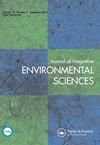Risk assessment of mortality from acute exposure to ambient fine particles based on the different toxicities of chemical compositions in China
IF 3.5
4区 环境科学与生态学
Q3 ENVIRONMENTAL SCIENCES
Journal of Integrative Environmental Sciences
Pub Date : 2021-01-01
DOI:10.1080/1943815X.2021.1912106
引用次数: 1
Abstract
ABSTRACT Health risks, including mortalities and morbidities, attributed to chronic or acute exposure to ambient fine particulate matter (PM2.5), have been assessed based on the increments in ambient concentrations. Different toxicities of the various chemical compositions in PM2.5 mixtures have been confirmed by epidemiological evidence but have rarely been considered. We proposed an approach to calculate the disease burden of both the chemical components and concentrations of PM2.5 by combining their pre-established dose–response relationships with a multivariate Gaussian model. We estimated that PM2.5 mixtures account for 0.43 (95% CI: 0.29 ~ 0.56) million premature deaths in China in 2013, consistent with estimates based on single-pollutant models in quantifying the total risk but with differing risk distributions. The residential, an elemental carbon-rich emission sector, accounted for approximately a quarter of PM2.5 emissions, but for half of the premature deaths attributable to air pollution, due to the stronger toxicity of carbonaceous particles than other PM2.5 compositions. Conventional risk assessments based on PM2.5 mass assume equality in the toxicity of PM2.5 compositions and may therefore fundamentally underestimate the skewness of the risk distribution and the adverse health effects of particles from the residential emissions. The different toxicities of the of PM2.5 compositions modify the risk estimates and thus should be included in emission reduction plans.基于中国不同化学成分毒性的环境细颗粒物急性暴露死亡率风险评估
慢性或急性暴露于环境细颗粒物(PM2.5)导致的健康风险,包括死亡率和发病率,已经根据环境浓度的增量进行了评估。流行病学证据证实了PM2.5混合物中各种化学成分的不同毒性,但很少考虑到这一点。我们提出了一种方法,通过将PM2.5的化学成分和浓度预先建立的剂量-反应关系与多变量高斯模型相结合,来计算PM2.5的疾病负担。我们估计,2013年PM2.5混合物在中国造成0.43万人(95% CI: 0.29 ~ 0.56)过早死亡,这与基于单一污染物模型的估计在量化总风险方面一致,但风险分布不同。住宅是一个富含元素碳的排放部门,约占PM2.5排放量的四分之一,但由于含碳颗粒比其他PM2.5成分的毒性更强,导致空气污染导致的过早死亡人数占一半。基于PM2.5质量的传统风险评估假设PM2.5成分的毒性相等,因此可能从根本上低估了风险分布的不均匀性和住宅排放颗粒物对健康的不利影响。两种PM2.5成分的不同毒性改变了风险估计,因此应纳入减排计划。
本文章由计算机程序翻译,如有差异,请以英文原文为准。
求助全文
约1分钟内获得全文
求助全文
来源期刊

Journal of Integrative Environmental Sciences
ENVIRONMENTAL SCIENCES-
CiteScore
3.90
自引率
0.00%
发文量
13
审稿时长
>12 weeks
期刊介绍:
Journal of Integrative Environmental Sciences (JIES) provides a stimulating, informative and critical forum for intellectual debate on significant environmental issues. It brings together perspectives from a wide range of disciplines and methodologies in both the social and natural sciences in an effort to develop integrative knowledge about the processes responsible for environmental change. The Journal is especially concerned with the relationships between science, society and policy and one of its key aims is to advance understanding of the theory and practice of sustainable development.
 求助内容:
求助内容: 应助结果提醒方式:
应助结果提醒方式:


